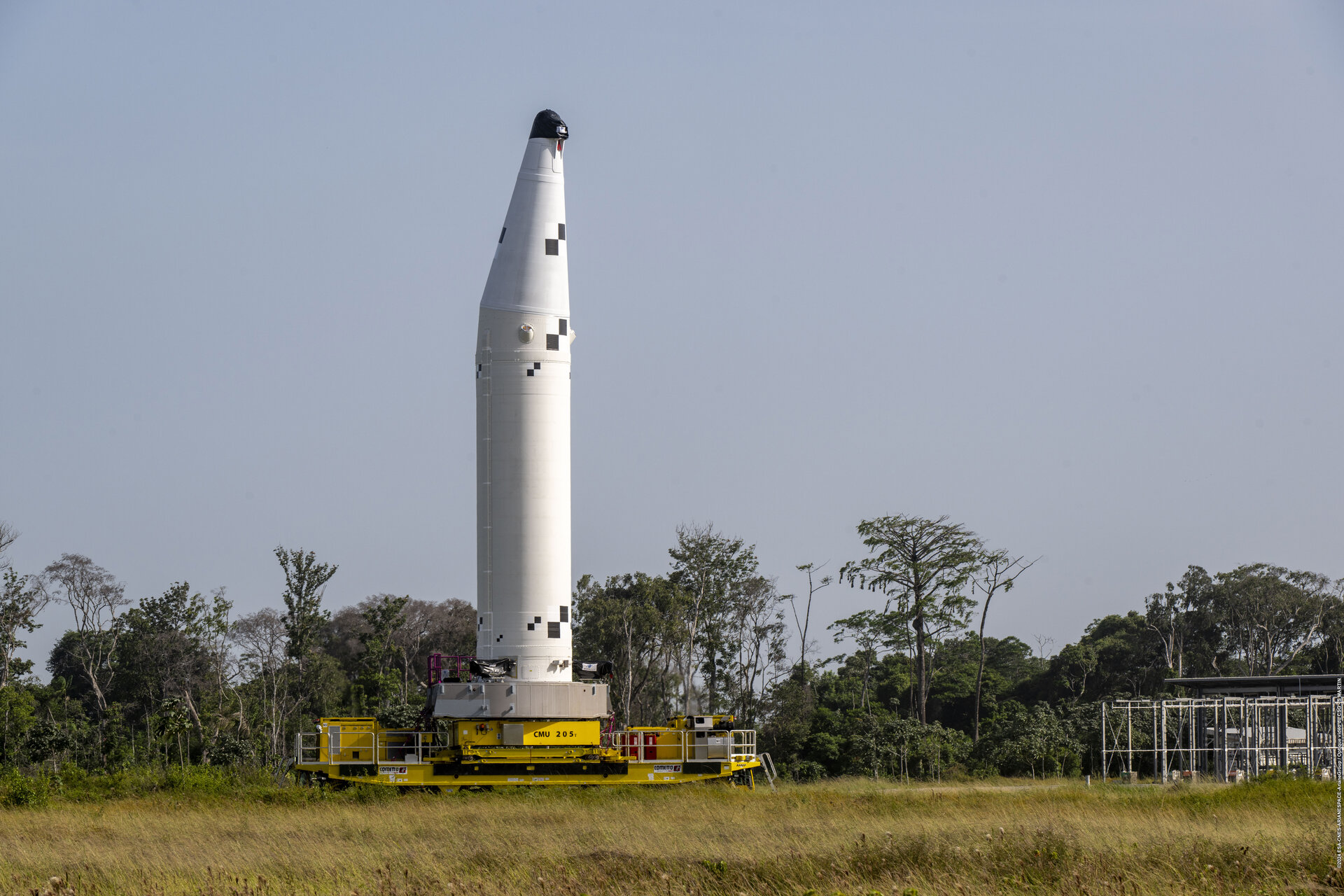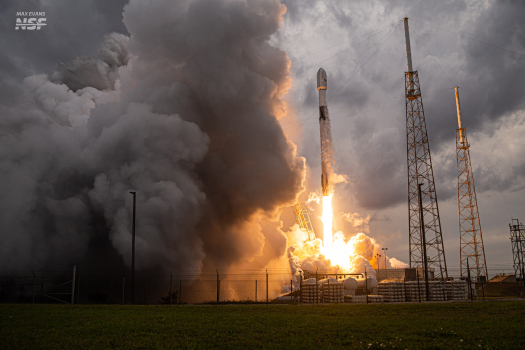The Shenzhou-16 (SZ-16) spacecraft has come home after its crew completed a six-month stay aboard the Chinese Tiangong space station. In addition, a Chang Zheng-6A successfully launched from Taiyuan the day after SZ-16’s return, and a commercial launch — involving CAS Space’s Kinetica-1 from Jiuquan — may also happen this week. A Chang Zheng-7A rocket is also now scheduled to fly from Hainan Island this week as well.
The Tiangong space station, permanently occupied since June 2022, has received a new crew aboard Shenzhou-17 to continue crewed space station operations. As a result, the crew of Shenzhou-16 is preparing to return home. They will have spent nearly 154 days in orbit after their successful landing on Tuesday, Oct. 31 at 00:11 UTC in the Gobi Desert.
Taikonauts Jing Haipeng, Zhu Yangzhu, and Gui Haichao, who launched to orbit aboard Shenzhou-16 on May 29, handed over Tiangong station operations to the Shenzhou-17 crew of Tang Hongbo, Tang Shengjie, and Jiang Xinlin before leaving the station. The spacecraft undocked from the Tiangong space station at 12:37 UTC on Oct. 30.
The taikonauts undocked from Tiangong and performed a photographic survey of the space station before they left. This was the first time the Chinese program has had taikonauts perform a high-resolution survey of Tiangong, which is presumably being done to inspect the station’s exterior for signs of damage or wear.
The taikonauts donned their launch and entry suits, which are based on the Russian Sokol suits used onboard the Soyuz spacecraft, sometime before reentry. The deorbit burn started somewhere over the South Atlantic before the spacecraft reentered the atmosphere.
The descent module of Shenzhou-16 will be the only part of the spacecraft that will survive reentry. After the docking module was jettisoned, the engines on the service module conducted the deorbit burn before the latter module was released. The descent module, with the crew onboard, encountered maximum reentry temperatures on the order of 2,000 degrees Celsius, while the interior could have seen temperatures of up to 40 degrees Celsius for a short time.
Shenzhou-16 was tracked by various assets in a line from a station in Swakopmund, Namibia — in sight of the deorbit burn — to the ESA station in Malindi, Kenya, and another Chinese station in Karachi, Pakistan. Yuanwang tracking ships have also been used in the past to support the deorbit burn, though it is not currently known if one is in position in the Atlantic. Tracking stations within China took over as the spacecraft drew closer to the landing site.

ESA tracking station in Malindi, Kenya, which has been used to support Shenzhou missions. (Credit: ESA)
The spacecraft deployed two pilot chutes at around 10,000 meters in altitude, followed by a drogue parachute, and then a single main chute at around 8,000 meters altitude while it descended to a touchdown approximately 50 kilometers north of Jiuquan – its launch site. Shenzhou’s ablative heat shield detached at an altitude of around 6,000 meters, and four small engines at the descent module’s base fired two seconds before touchdown to soften the landing.
This sequence, like many other functions of the Shenzhou spacecraft, is derived from Soyuz spacecraft operations. Also derived from Soyuz operations are the procedures the Chinese use for the recovery of the taikonauts and the spacecraft itself.
The taikonauts were carried out of the spacecraft similarly to Soyuz cosmonauts. The crewmembers were seated through the recovery process and have been taken for medical evaluation in separate vehicles as they adapt to Earth’s gravity. Like the Russian program, the Chinese also use military helicopters based on the Mil Mi-8 design during spacecraft recovery operations, along with other types based on Western designs, as well as numerous ground vehicles.

Shenzhou-15 after touchdown in the Gobi Desert. Note the helicopter in the background. (Credit: Xinhua)
The Chinese human spaceflight program is run by the military, under the aegis of the China Manned Space Agency, and up until Shenzhou-16, all taikonauts who flew into space were military officers. Gui Haichao is the first civilian to fly to space aboard a Chinese spacecraft, and the program has opened up to applicants from Hong Kong and Macau.
In addition, foreign crewmembers may be included in future Chinese human spaceflight missions. China also has signed on Belarus, Pakistan, and Azerbaijan this month to the planned International Lunar Research Station, a Moon base planned for the 2030s to be an alternative to the NASA-led Artemis program.
Chinese launches this week
Besides the Shenzhou-16 landing, China was also thought to be planning to launch a Chang Zheng-4C (CZ-4C) rocket from LC-9 at the Taiyuan Satellite Launch Center in northern China. However, a Chang Zheng-6A (CZ-6A) flew instead from LC-9A at Taiyuan. The flight launched successfully on Tuesday, Oct. 31 at 22:50 UTC, nearly 23 hours after the Shenzhou touchdown in the Gobi Desert.
The Taiyuan launch site is typically used for payloads needing to go to a Sun-synchronous polar orbit, and the payload aboard this flight was the Tianhui-5 cartographic survey satellite. These types of satellites often use Sun-synchronous orbits so they can fly over a given spot on Earth at the same time of day every 24 hours.
The CZ-6A, a modern replacement for earlier Chang Zheng series rockets, has flown since last year and is capable of lofting up to 4,500 kilograms to a Sun-synchronous polar orbit. The rocket uses two stages and kerosene plus liquid oxygen as propellants, with four solid rocket boosters. The CZ-6A is the first Chinese launch vehicle to use SRBs, and this is the fourth overall CZ-6A launch plus the second of 2023.
The Chinese commercial spaceflight company CAS Space may also be flying a mission this week, though a launch date, time, and payload have not been revealed. The current date is listed as NET November 2023, after earlier having a NET October date.

CAS Space’s Lijian-1 in the horizontal position prior to launch. (Credit: CAS Space)
The company’s Kinetica-1 vehicle, also known as Zhongke-1A or Lijian-1, is a rocket with four solid-fueled stages. This rocket, capable of a payload of up to one and a half tonnes to a Sun-synchronous polar orbit, has flown successfully twice – since July 2022. The third flight of Kinetica-1, like the first two, would occur from the Jiuquan Satellite Launch Center, and Site 130 was developed specifically for this rocket. This would be the second flight for Kinetica-1 in 2023.
CAS Space, headquartered in the southern city of Guangdong, is planning an upgraded Kinetica-1A vehicle, as well as reusable liquid-propellant rockets. A suborbital space tourism launcher that is similar to Blue Origin’s New Shepard rocket is also planned. To this end, the company raised $87 million US dollars this spring from a Series C funding round.
On Friday, Nov. 3, a Chang Zheng-7A (CZ-7A) is scheduled to fly from LC-201 at the Wenchang Space Launch Site on Hainan Island off the southern Chinese coast. Launch time is 15:00 UTC. The payload has not been disclosed.
The CZ-7A is capable of carrying up to 7,000 kilograms to geostationary transfer orbit or 12,000 kilograms to low-Earth orbit. The base CZ-7 rocket is a replacement for earlier medium-lift vehicles like the CZ-2F used to launch Shenzhou spacecraft, and its two stages plus four strap-on boosters use liquid oxygen and kerosene for propellant.
The CZ-7A, unlike the original CZ-7, uses a third stage with liquid oxygen and liquid hydrogen as propellants. This version would be used for geostationary transfer orbit launches. Hainan Island is closer to the Equator than any other Chinese space launch center and is well placed for geostationary satellite launches as well as launches to other inclinations.
A navigational warning posted for the flight shows that it will be using a due east trajectory, which is typically used by geostationary transfer orbit launches.
(Lead image: The Shenzhou-16 crew portrait before the flight. Credit: Xinhua)






